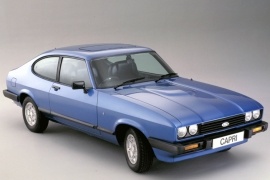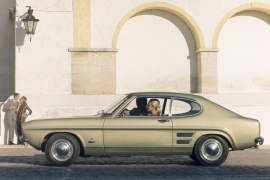FORD Capri Models/Series Timeline, Specifications & Photos
First production year: 1969
Engines: Gasoline
Body style: Coupé (two-door)
Also known as the Capri MKIII, Ford's 1978 coupe for the European market was a heavily revised 1976 Capri MKII.
Ford made the Capri to be everyone's grand tourer. It offered a similar style at the price of a regular, family sedan. No wonder that, in 1977, the Capri was the seventh most sold car in the U.K. Ford pushed harder its engineers to make the vehicle even more fuel-efficient and improved the aerodynamic and the powertrains. Fortunately, it didn't change its overall shape.
At the front, the 1978 Capri featured an improved design with quad headlights. Its plastic grille resembled the same idea from the Fiesta and Granada. At the bottom, an apron reduced the air quantity that entered under the car. These modifications improved the car's aerodynamic by almost six percent and reduced the lift by 18 percent. At the back, a spoiler was mounted on specific versions. All these modifications decreased fuel consumption by ten percent. Another particular detail for the 1978 Capri was the matte black door handles and windows surroundings. Later models featured color-coded door mirrors and grille.
Inside, the base version was simple and, somehow, dull. On the other hand, the Sport version was available with Recaro sport bucket seats and a complete dash with an original Ford radio-cassette player.
Under the hood, Ford kept the base engines for their high-volume sales but added impressive engines such as the 2.8-liter fuel-injected version paired to a 5-speed manual. In South Africa, a particular shop used to install the big, 5.0-liter Ford V-8 engine in the Capri. But it was too nose-heavy, and the agile car became unstable.
FORD Capri 1.3L 4MT RWD (57 HP)
FORD Capri 1.3L 4MT RWD (60 HP)
FORD Capri 1.6L 3AT RWD (72 HP)
FORD Capri 1.6L 3AT RWD (74 HP)
FORD Capri 1.6L 3AT RWD (88 HP)
FORD Capri 1.6L 3AT RWD (91 HP)
FORD Capri 1.6L 4MT RWD (72 HP)
FORD Capri 1.6L 4MT RWD (74 HP)
FORD Capri 1.6L 4MT RWD (88 HP)
FORD Capri 1.6L 4MT RWD (91 HP)
FORD Capri 2.0L 3AT RWD (101 HP)
FORD Capri 2.0L 3AT RWD (98 HP)
FORD Capri 2.0L 4MT RWD (101 HP)
FORD Capri 2.0L 4MT RWD (98 HP)
FORD Capri 2.0L V6 3AT RWD (90 HP)
FORD Capri 2.0L V6 4MT RWD (90 HP)
FORD Capri 2.3L V6 3AT RWD (108 HP)
FORD Capri 2.3L V6 3AT RWD (114 HP)
FORD Capri 2.3L V6 4MT RWD (108 HP)
FORD Capri 2.3L V6 4MT RWD (114 HP)
FORD Capri 2.8L V6 5MT RWD (160 HP)
FORD Capri 2.9L V6 4MT RWD (177 HP)
FORD Capri 3.0L V6 3AT RWD (138 HP)
Ford tried to replicate the Mustang's success in Europe and introduced the sporty coupe Capri in 1969, although this car's performance didn't match those of its American sibling.
There were many differences between American and European customers' requirements. While the U.S. buyers asked for powerful engines, those from the Old Continent needed nimble vehicles for twisty roads. In addition, due to the fuel price, they asked for fuel-efficient engines. That's how the Capri was born: a sport-looking car with a heart of an econobox.
At first sight, the Capri looked like it could hide an inline-six under its long hood. Its cab-rearward design made it look like a sports car. In addition, the sloped-down rear windscreen and the short deck amplified the fast-vehicle look. Furthermore, on the sides, a sculptured line adorned the front fenders, continued on the doors, and ended in front of the rear wheel arches with a pair of side fake air intakes. Finally, the rear fascia featured two small horizontal taillights. At least Ford could've used the three vertical lamps design from the Mustang.
Inside, the Capri featured a pair of bucket seats at the front and a bench for two in the rear. The instrument panel was designed with a sports car layout, where the speedometer and tachometer were mounted in individual clusters. In addition, the automaker offered four additional dials for various engine functions. The low seating position and the short gear stick amplified the car's sporty feeling.
But most vehicles left the factory with mundane powerplants carried over from cars such as the Taunus and the Kent 1.3-liter inline-four engines. Yet, the car was sold in significant numbers. It managed to sell over 400,000 units in its first two years.
FORD Capri 1.3L 4MT RWD (63 HP)
FORD Capri 1.5L 3AT RWD (80 HP)
FORD Capri 1.5L 4MT RWD (80 HP)
FORD Capri 1.6L 3AT RWD (72 HP)
FORD Capri 1.6L 4MT RWD (72 HP)
FORD Capri 1.7L 3AT RWD (75 HP)
FORD Capri 1.7L 4MT RWD (75 HP)
FORD Capri 2.0L V6 3AT RWD (113 HP)
FORD Capri 2.0L V6 4MT RWD (113 HP)
FORD Capri 2.3L V6 3AT RWD (126 HP)
FORD Capri 2.3L V6 4MT RWD (126 HP)
FORD Capri 2.3L V6 Turbo 4MT RWD (180 HP)
FORD Capri 2.6L V6 3AT RWD (142 HP)
FORD Capri 2.6L V6 4MT RWD (142 HP)
FORD Capri 2.6L V6 RS 4MT RWD (150 HP)

